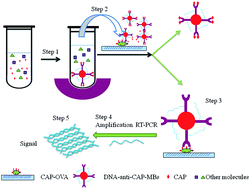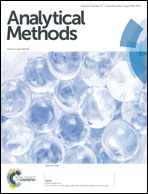Development of a highly sensitive real-time immuno-PCR for the measurement of chloramphenicol in milk based on magnetic bead capturing†
Abstract
Chloramphenicol (CAP) is a forbidden antibiotic that enters the food chain by illegal use in food-producing animals, potentially causing aplastic anaemia in humans. Immuno-PCR has the potential to address the need of meeting strict limits for this antibiotic by detecting trace levels of CAP present in animal-derived foods. A real-time immuno-quantitative PCR (RT-IPCR) assay for the quantification of CAP based on the simple and quick immunomagnetic bead recovery of CAP in milk was developed. The immunomagnetic beads were obtained by linking the reporter DNA to anti-CAP monoclonal antibody with N-succinimidyl S-acetylthioacetate (SATA) and succinimidyl-4-(N-maleimidomethyl)cyclohexane-1-carboxylate (SMCC) and immobilising the anti-CAP monoclonal antibody/DNA-label conjugate on the magnetic beads with 1-ethyl-3-(3-dimethyl-aminopropyl)carbodiimide hydrochloride (EDC) and N-hydroxysulfosuccinimide (SNHS). The RT-IPCR assay allows the sensitive detection and quantification of CAP in the concentration range of 0.001–0.11 μg L−1 (R2 = 0.9986) with a 50% inhibition concentration (IC50) value of 0.008 μg L−1. The RT-IPCR approach discussed here is presented as a model system that could be easily adapted for small molecule detection in a variety of foods using simple immunomagnetic bead recovery.


 Please wait while we load your content...
Please wait while we load your content...